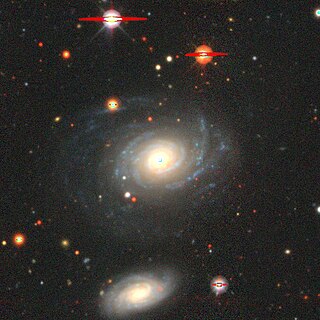
NGC 1 is an intermediate spiral galaxy of the morphological type Sbc, located in the constellation of Pegasus. It was discovered on 30 September 1861 by Heinrich d'Arrest.

NGC 4881 is an elliptical galaxy in the northern constellation of Coma Berenices. It was discovered by the German astronomer Heinrich Louis d'Arrest on April 22, 1865. John L. E. Dreyer described it as "faint, small, a little extended, 9th magnitude star to southwest". This object is located at a distance of approximately 309 megalight-years from the Milky Way. It is a member of the Coma cluster of galaxies, positioned around 18′ to the north of the cluster's center with no nearby galactic neighbors.

NGC 4725 is an intermediate barred spiral galaxy with a prominent ring structure, located in the northern constellation of Coma Berenices near the north galactic pole. It was discovered by German-born astronomer William Herschel on April 6, 1785. The galaxy lies at a distance of approximately 40 megalight-years from the Milky Way. NGC 4725 is the brightest member of the Coma I Group of the Coma-Sculptor Cloud, although it is relatively isolated from the other members of this group. This galaxy is strongly disturbed and is interacting with neighboring spiral galaxy NGC 4747, with its spiral arms showing indications of warping. The pair have an angular separation of 24′, which corresponds to a projected linear separation of 370 kly. A tidal plume extends from NGC 4747 toward NGC 4725.
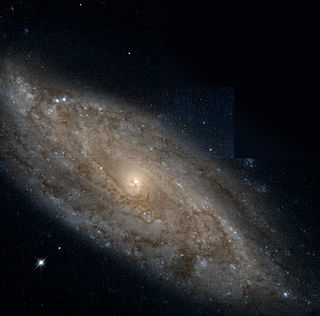
NGC 7314 is a spiral galaxy located in the southern constellation of Piscis Austrinus. It was discovered by English astronomer John Herschel on July 29, 1834. This is a nearby Seyfert (active) galaxy, located at a distance of approximately 54.6 megalight-years from the Milky Way. Since it appears to have detached spiral arm segments, it was listed in Halton Arp's Atlas of Peculiar Galaxies.

NGC 321 is an elliptical galaxy located in the constellation Cetus. It was discovered on September 27, 1864, by the astronomer Albert Marth. Measurements of its redshift put it at a distance of about 217.4 ± 15.4 megalight-years (66.67 ± 4.73 Mpc), assuming a Hubble constant of H0 = 67.8 km/sec/Mpc.

NGC 1560, also known as IC 2062, is an 11th-magnitude spiral galaxy, in the IC 342/Maffei Group. It was discovered by Wilhelm Tempel on August 1, 1883.

NGC 62 is a barred spiral galaxy in the constellation Cetus. NGC 62 is its New General Catalogue designation. It has an apparent magnitude of 13.2.

NGC 63 is a spiral galaxy in the constellation Pisces. NGC 63 is its New General Catalogue designation. It has an apparent V-band magnitude of 12.70.
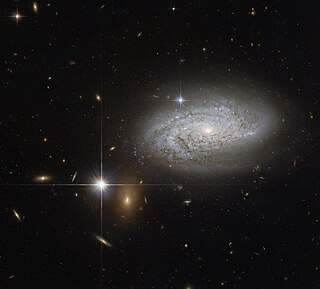
NGC 3021 is a spiral galaxy in the northern constellation of Leo Minor. It is about 93 million light-years away from Earth, and is receding with a heliocentric radial velocity of 1,537±4 km/s. This galaxy was discovered December 7, 1785 by Anglo-German astronomer William Herschel. The morphological classification of NGC 3021 is SA(rs)bc, which indicates a spiral galaxy with no central bar (SA), an incomplete inner ring structure (rs), and moderate to loosely wound spiral arms (bc).

NGC 119 is an unbarred lenticular galaxy with an apparent magnitude of 13.0 located in the constellation Phoenix. It was discovered on October 28, 1834, by the astronomer John Herschel.

NGC 120 is a lenticular galaxy of type SB0? pec? with an apparent magnitude of 13.4 located in the constellation Cetus. It was discovered on 27 September 1880 by Wilhelm Tempel.

NGC 127 is a lenticular galaxy that was discovered on November 4, 1850, by Bindon Stoney, the same day he discovered NGC 126 and NGC 130. NGC 127 is a gas-rich, star-forming galaxy showing emission lines. It is an interacting companion to the peculiar, edge-on galaxy NGC 128, and the pair are connected by a bridge of material. The south-east part of NGC 127 is asymmetrical in the direction of NGC 128. It may have recently passed the more massive NGC 128, from which an infall of gas is flowing onto NGC 127.
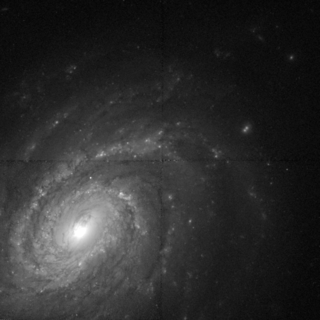
NGC 214 is a spiral galaxy in the northern constellation of Andromeda, located at a distance of 194 megalight-years from the Milky Way. It was discovered on September 10, 1784 by William Herschel. The shape of this galaxy is given by its morphological classification of SABbc, which indicates a weak bar-like structure (SAB) at the core and moderate to loosely-wound spiral arms (bc).

NGC 266 is a massive barred spiral galaxy in the constellation Pisces. NGC 266 is located at a distance of 197 megalight-years from the Milky Way. It was discovered on September 12, 1784, by William Herschel. The form of this barred galaxy is described by its morphological classification of SB(rs)ab, which indicates a quasi-ring-like structure (rs) and moderate-to-tightly wound spiral arms (ab). It is the dominant member of a small group with six low-mass galaxies.

NGC 4500 is a barred spiral galaxy in the constellation Ursa Major. The galaxy was discovered on April 17, 1789 by William Herschel. It is a blue compact galaxy.

NGC 3001 is a magnitude 11.83 spiral galaxy in the constellation Antlia, discovered on 30 March 1835 by John Herschel. It has a recessional velocity of 2,465 kilometres (1,532 mi) per second, and is located around 115 million light years away. NGC 3001 has an apparent size of 4.3 by 3.1 arcminutes and is about 145 thousand light years across.

NGC 970 is an interacting galaxy pair in the constellation Triangulum. It is estimated to be 471 million light-years from the Milky Way and has a diameter of approximately 100,000 ly. The object was discovered on September 14, 1850, by Bindon Blood Stoney.
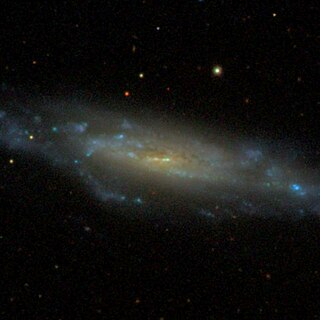
NGC 3003 is a nearly edge-on barred spiral galaxy in the constellation of Leo Minor, discovered by William Herschel on December 7, 1785. It has an apparent visual magnitude of 11.78, at a distance of 19.5 Mpc from the Sun. It has a recessional velocity of 1474 km/s.

NGC 3156 is a lenticular galaxy located in the constellation Sextans. It is located at a distance of about 75 million light-years from Earth and is forming a pair with NGC 3169. It was discovered by astronomer William Herschel on December 13, 1784.

NGC 959 is a spiral galaxy in the northern constellation of Triangulum. It was discovered on November 9, 1876, by French astronomer Édouard Stephan. This galaxy is located at a distance of 36 million light years and is receding with a heliocentric radial velocity of 596 km/s. It is a member of the NGC 1023 Group of galaxies.




















